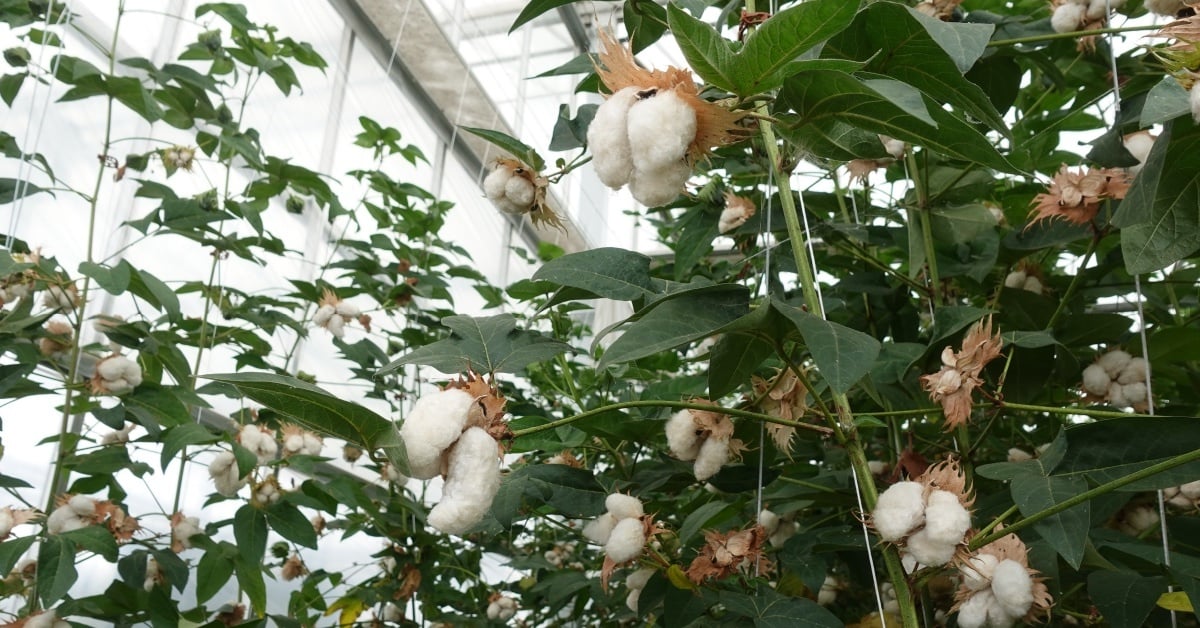
When the American PVH Corp, the French Kering Group and the textile producer Arvind Limited join forces to grow cotton in a resource-efficient way, it tells us one thing: the fiber is indispensable in fashion and will not be replaceable anytime soon. Currently, cotton is the most widely used fiber in the world. Almost 30 percent of all textiles are made from this natural raw material. Its enormous popularity is due to its durability and unsurpassed wearing comfort.
At the same time, cotton has recently fallen into disrepute because of its poor environmental performance. Cotton is responsible for 24 percent of the world’s insecticide use (Source: Textile Exchange 2018). Growing cotton requires up to 10,000 liters of water per kilogram (Source: cottonconnect.org). It also takes up land that would also be sorely needed for food production. If cotton is to be grown in a resource-efficient way, new technologies are urgently needed, according to the research consortium led by the Dutch innovation platform Fashion for Good.
Extra-long staple cotton varieties
The goal of making cotton farming resource efficient is all the more challenging when it comes to growing extra-long staple (ELS) cotton varieties in the Gujarat region of India. The term “staple” stands for the most important quality characteristic of cotton, namely its fiber length. The longer the fiber, the higher the quality. Compared to medium and short-staple cottons, extra-long-staple cottons can be used to produce finer and at the same time stronger yarns. Fabrics made from these fibers wear less and have a longer life. Wear and tear occurs through wearing and washing.
Also interesting: Breakthrough in recycling clothing with polyamide
ELS cottons are also desirable in terms of the circular economy. “Current cotton recycling methods unfortunately reduce the average fiber length. Therefore, the textile industry wants to have the longest fibers for their fabrics,” explains Georgia Parker, Innovation Manager at Fashion for Good.
The Gujarat region
Currently, ELS account for only about two to three percent of the world’s cotton supply. That’s because high-quality cotton plants are very delicate. “Each variety has unique requirements. But in general, it is stable growing conditions that lead to the best fiber quality. Stress from temperature fluctuations, humidity, water and nutrient deficiencies, or pest infestations can affect final quality. In addition, ELS also have a longer growing season, which adds to the need for preferable conditions,” Parker says.
Traditionally, ELS cotton varieties are grown in the southern states of India, where summers are on average 10 degrees cooler and rainfed agriculture can be practiced. This is a form of soil cultivation that relies solely on water from rainfall. It therefore requires no additional artificial irrigation.
Resource efficient
The research project is being carried out on a cultivation area of 1.5 hectares in the Gujarat region. Here, the average annual temperature is 32 degrees. This means it is extremely hot and dry. The British technology partner Materra (formerly hydroCotton) has expertise in the management of climate-resistant cotton cultivation. After multiple tests in the UK, the process will now be adapted to Gujarat’s climate and resources. “This pilot project will demonstrate that growing complicated cotton varieties such as ELS is possible in regions where it is challenging. In addition, scaling the technology will bring a new revenue stream to the region and boost the economy,” Parker says.
Georgia Parker, Innovation Manager at Fashion for Good
“This pilot project will show that growing complicated cotton varieties like ELS is possible even in regions where it is challenging.”
Materra combines precision agriculture and environmental control in its innovative farming method. The latter is ensured through the use of sensors. Throughout the process, data is collected in real time to ensure the final quality of the product. This involves measuring the resources used in growing the cotton as well as the humidity and temperature. It can also monitor social factors such as working conditions and labor use.
Precise irrigation system
It is a common misconception that cotton is a water-intensive crop. In fact, it is drought tolerant, Parker says. She attributes this misconception to the social and economic factors associated with its cultivation. More than 60 percent of global cotton production takes place
More than 60 percent of global cotton production takes place on small cotton farms. Over 90 percent of these estimated 100 million smallholders live in developing countries and farm less than two hectares. Says Singh, “Irrigation systems could save large amounts of water. But farmers can’t invest because the selling price of cotton is low and they can’t get affordable financing. Instead, they use free methods that are water-intensive, such as furrow or flood irrigation.” Furrow irrigation is applied to crops grown in rows. Water is transported between crop rows via individual channels.
Materra’s innovative irrigation system can prevent excessive water loss. Agricultural inputs are delivered directly to the root system where they can be efficiently absorbed.
Pest control
In addition, the method is pesticide-free. The technology company controls pest outbreaks with natural predators. In Gujarat, it is the native lacewing that kills the pests found on cotton. As a broad-spectrum predator, it eats many different pests rather than specializing in just one.
The harvest on the test plot in Gujarat is expected to be three tons of cotton. The three industry partners plan to share the volume. The resulting garments are expected to be available in stores by 2023. Calvin Klein, a PVH Corp company wants to switch production completely to sustainable cotton by 2025. This project aims to make it happen.
Materra will use the data and insights from the pilot to select the next suitable test site. Widespread implementation of the technology is expected to enable smallscale farmers to increase their harvests and grow more commercially attractive extra-long staple cotton varieties. At the same time, the technology will have a positive impact on the environment and ensures improved traceability of the upstream supply chain.
Also interesting: How cotton is becoming smart



